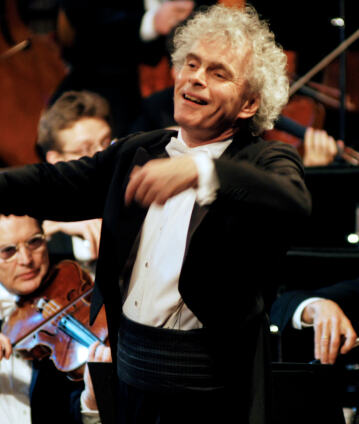Sir Simon Rattle conducts “Carmina Burana” at the 2004 New Year’s Eve Concert

What could be more obvious than to ring in a new year with an appeal to the goddess Fortuna? And this is precisely what happened at this New Year’s Eve Concert, when Sir Simon Rattle conducted the Berliner Philharmoniker in a performance of Carl Orff’s Carmina Burana – a bright musical panorama which wondrously unites the most diverse spheres of expression: the archaic and the modern, grandiosity and humour, and the finest sophistication with raw power.
Orff’s cantata is a setting of often highly profane medieval poems named after the Abbey of Benediktbeuren, where these Songs of Beuren were discovered. Written in a mixture of Latin and Middle High German, they graphically hymn the pleasures of eating, drinking, gambling and loving, encouraging Orff to create the musical equivalent of a brightly coloured illustrated broadsheet whose verve and range of colour have turned this into one of the most frequently performed works of the 20th century.
At this Philharmoniker’s New Year’s Eve Concert, the critic of the Tagesspiegel was impressed most of all by “the instrumental colours of the orchestral musicians, by the sound mixtures produced by the chorus and by the seductive skills of the soloists. A trained percussionist, Simon Rattle was able to unleash forces that time and again recalled Stravinsky’s The Rite of Spring: a springtime festival that ends on a positive note.” The concert’s no less festive framework was provided by Ludwig van Beethoven’s jubilant Leonore Overture and, as a splendid end to the evening, the “Hallelujah” Chorus from Handel’s Messiah.
© 2004 EuroArts Music International
Category
Artists
Our recommendations
- Simon Rattle conducts Mozart and Strauss at the 2006 New Year’s Eve Concert
- 2013 New Year’s Eve Concert with Simon Rattle
- Sir Simon Rattle conducts a Mozart Gala at the 2005 New Year’s Eve Concert
- Simon Rattle conducts Bernstein’s “Wonderful Town” at the 2002 New Year’s Eve Concert
- 2014 New Year’s Eve Concert with Simon Rattle and Menahem Pressler
- 2018 New Year’s Eve Concert with Daniel Barenboim